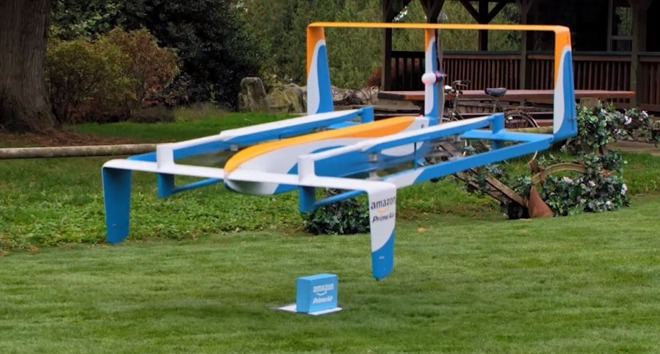What's really standing in the way of drone delivery?

What's really standing in the way of drone delivery?
original article -- by Ben Popper -- The Verge
-----------------------------------
Amazon, Google, and the FAA all have different opinions on what needs to happen next

Drones zipping above our cities, landing on rooftops to drop off a bottle of Tylenol or a hot pizza, then flying home to charge their batteries. It sounds like a far-off fantasy world, the kind of futuristic project that companies trot out to generate press coverage but has little chance of becoming a reality anytime soon. And yet two of the world’s biggest companies, Amazon and Google, are starting to confidently assert that they have the technology to implement this kind of business now, if only the regulators would get out of the way.
Last week I attended a panel in Las Vegas that included Google, Amazon, NASA, and a former FAA official with intimate knowledge of that agency’s stance on drones. It gave the clearest picture yet of how the biggest stakeholders in the United States are thinking about what needs to happen for drone delivery to take off. On both the technical and legal hurdles, there was a wide range of opinions on how aggressive the industry should be, and on what level of risk, or regulation, was worth accepting to forge this new era of aviation.
Many passenger jets already rely on software to fly and land, with humans manually controlling some planes for an average of seven minutes or less during each flight. Yet so far the Federal Aviation Administration is insisting that drones must always be controlled by a human pilot and stay within that person’s line of sight, regulations which eliminate the possibility of a large-scale drone delivery fleet.
How can the drone industry move beyond these restrictions? Paul Misener, Amazon’s vice president for global public policy, believes tech companies only need a chance to prove they can fly safely. "I would say we need regulatory permissions," Misener said, opportunities to fly autonomously with certain restrictions. Amazon has been testing outside the US for the last year and prodding the FAA to give them a set of performance- and risk-based standards they can test against. They don’t want to be told what kind of technology they can use, because they plan on experimenting and iterating quickly. But given certain thresholds for communication, latency, and obstacle avoidance, Misener expressed confidence they can make it work. So far, the FAA is continuing to make them wait.
PUSHING FOR PERMISSION TO EXPERIMENT IN THE US
Amazon’s vision for drone delivery carves out the airspace between 200 and 400 feet for high-speed transit. There is a no-fly zone between 400 and 500 feet, keeping drones distinct from crewed aircraft. Amazon is building drones that can communicate with one another, sharing their location and flight path. They will also have what’s known as "sense and avoid" technology onboard, sensors that can detect obstacles around them and dodge accordingly.
"There is something called collaborative sense and avoid where flying objects identify themselves to each other and you can avoid them on that basis. There are existing technologies used for [crewed] aircraft that do this quite well. But there are a lot of non-collaborative objects out there," said Misener. At low altitudes, drones could easily encounter birds or balloons, objects "that you can’t predict and they are certainly not broadcasting their position." For that reason, high-performance sense and avoid is a must for Amazon.
Making perfect sense and avoid technology the prerequisite for commercial drone flight could delay, or even doom the industry, because sense and avoid isn’t perfect now and may never be. Intel, which showed off the most advanced sense and avoid technology at CES last week, confirmed this problem. "We tested multiple drones abroad: intuitive, adaptive, depth sensing, smart drones. There’s an error rate," said Peter Cleveland, a VP with Intel’s Law and Policy Group. "A very, very low error rate, but it has to do with a communication link and latency."
/cdn0.vox-cdn.com/uploads/chorus_asset/file/5909705/Screen_Shot_2016-01-15_at_8.29.46_PM.0.png)
Google took a much more aggressive approach. "I think there are no hurdles, we just need to do it," said Dave Vos, the head of Google’s Project Wing . "The biggest hurdle is the culture, not inventing more problems than we need to solve." Vos spent several decades building systems to power autonomous vehicles, starting with a unicycle at MIT and finishing at Rockwell Collins , whose technology is deployed in both military and commercial jets, most of which fly on autopilot for the majority of the time they spend in the air. "This is not a technology challenge anymore. [Airplanes] are all automated."
Google’s Vos wants to solve the problem of imperfect sense and avoid by moving away from this technology as a critical component altogether. Instead of focusing on new rules for how well a drone can see, Vos argues drones should simply follow the established rules for crewed aircraft: announce their flight plans before takeoff and broadcast their location and trajectory as they go. "I would advocate strongly that the need for additional regulation is very, very small," said Vos. "That in fact if you allowed people to do things, and to replicate what is done by [crewed] aviation, pilots, in this airspace, it already works. So we don’t need new regulations, we just need to be allowed to go do it."
NASA, which is acting as the connective tissue between private industry and the FAA, has been pushing slowly past the limitations imposed on companies like Google and Amazon. NASA worked alongside the FAA to complete tests with BSNF railroad where a drone inspected hundreds of miles of track, flying well beyond the operator’s line of sight. In October of this year, that government plans to conduct tests of completely autonomous drones, seeing how well they can communicate their location, avoid obstacles, and coordinate their movements.
Parimal Kopardekar, who is leading NASA’s effort to create a traffic management system for autonomous aircraft , noted that the creation of the FAA came in response to a crisis: the 1956 collision of two aircraft over the Grand Canyon . With drones, he says, "we wanted to avoid repeating the history."
But as the panel drew to a close, Jim Williams , a former FAA official who recently left for private practice at a high-powered law firm, offered a very different conclusion. To realize the ambitious goals of a full scale drone industry, there will almost certainly have to be some regrettable accidents. That’s not cynicism, he argued. It’s just being realistic.
"The objective is to find the spot that the community you’re operating in is comfortable with and that the FAA is comfortable with and then you go forward and adjust if something does happen. Because that is really the history of aviation." Williams told the crowd. "Since the very first flights, there have been crashes and ... you try and learn from it and prevent that from happening again. It’s a wonderful thing that we have a transportation system that’s the best in the world, but it’s based on a lot of people who had to die to make it that good. You don’t learn by arguing about how to do it. You learn by doing it."
Tags
Who is online
60 visitors

This feels to me like something that is going to happen.
I'm not sure how they get past liability issues. It doesn't seem safe.
True, but I'd guess they have lawyers...
Also, they're probably working on a "degraded" mode that would bring the drone down somewhere safe in the event of a problem.
I'm ok with it if they can address safety issues. The FAA really needs to address this issue. I'm not generally in favor of even more laws and regulations, but sometimes new technology demands them.
There are many useful purposes for drones, but delivering crap from Amazon doesn't sound like one of them. As it is, you can order something from Amazon and have it on your doorstep for a minimal or negligible cost in a couple days, which is amazing. Who really needs their Amazon crap faster than that? Is it really worth it to have the skies filled with delivery drones, just so people can be that much more lazy, demanding and materialistic?
Well said. There may be useful applications, but faster delivery of DVDs is probably not one of them.
Do I understand that you are not an Amazon customer? If your image of Amazon is "crap", then you need to update.
Amazon sells damn near everything.
I presume that, at least at first, the drones would deliver only light-weight, high value items. But I also presume that Amazon means to go further.
I use Amazon all the time, I just don't see a need to have anything I order show up the same day that I order it for a premium charge. I didn't mean to imply that their products are low quality, I just think that the typical American (myself included) has far more crap than they really need, and Amazon fuels that fire.
Drones have many uses :
DARPA's New Battle Drone Makes Every Navy Ship an Aircraft Carrier
I think drones are incredible. They will allow us to accomplish so many things that right now are cumbersome, costly or dangerous to highlight a few. What I'm not hearing a lot of discussion on is how introducing drones into our everyday lives will impact jobs for people and not just in the area of retail. As much as using drones will improve the quality of life it also has the potential of taking away much needed jobs from humans. Replacing humans with drones has very serious implications that will have a rippling affect in our society.
how introducing drones into our everyday lives will impact jobs for people
I think you've hit the key point. How many UPS trucks are running around America's cities? They'd pay for a bunch of drones.